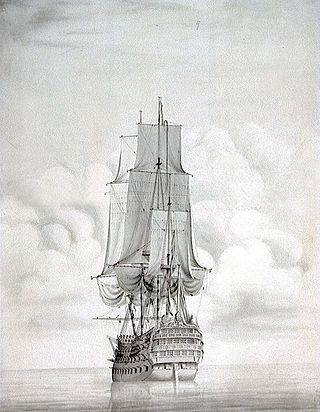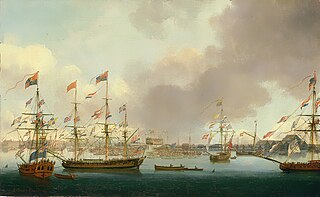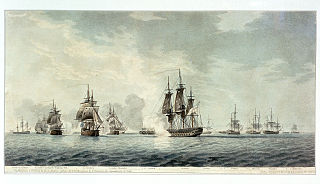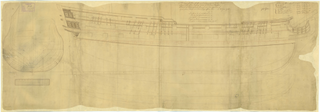
HMS Vanguard was a 90-gun second-rate ship of the line of the Royal Navy, built at Portsmouth Dockyard and launched in 1678.
Six Royal Navy ships have been called HMS Hero:

HMS Cornwall was an 80-gun, third rate, ship of the line built for the Royal Navy in the 1690s. She served in the War of the Grand Alliance, and in her first year took part in the Battle of Barfleur and the action at La Hougue.
HMS Prince Consort was the first ship to carry this name in the Royal Navy. Laid down as HMS Triumph, at HM Royal Dockyard, Pembroke as a 91-gun screw second-rate line-of-battle ship, she was renamed HMS Prince Consort on 14 February 1862 following the death of Prince Albert of Saxe-Coburg and Gotha, the husband of Queen Victoria.

HMS Alexander was a 74-gun third-rate of the Royal Navy. She was launched at Deptford Dockyard on 8 October 1778. During her career she was captured by the French, and later recaptured by the British. She fought at the Nile in 1798, and was broken up in 1819. She was named after Alexander the Great.

HMS Zealous was a 74-gun third-rate ship of the line of the Royal Navy, built by Barnard of Deptford and launched on 25 June 1785.

HMS Culloden was a 74-gun third rate ship of the line of the Royal Navy, launched on 16 June 1783 at Rotherhithe. She took part in some of the most famous battles of the French Revolutionary Wars and the Napoleonic Wars before she was broken up in 1813.

HMS Culloden was a 74-gun third-rate ship of the line of the Royal Navy, built according to the dimensions laid out by the 1741 proposals of the 1719 Establishment at Deptford Dockyard, and launched on 9 September 1747. She was the first ship to bear the name, and was named for the Battle of Culloden, which had been fought the previous year.

HMS Audacious was a 74-gun third-rate ship of the line of the Royal Navy, launched on 23 July 1785 at Rotherhithe. She was the first ship to bear the name.

HMS Benbow was a 74-gun third rate ship of the line of the Royal Navy, built by Brent of Rotherhithe and launched on 3 February 1813.

HMS Northumberland was a 70-gun third-rate ship of the line of the Royal Navy, built at Deptford Dockyard and launched in 1705.

HMS Bombay was a 74-gun third rate ship of the line of the Royal Navy, launched on 28 March 1808 at Deptford.

HMS Falkland was a 50-gun fourth-rate ship of the line of the Royal Navy, built by Holland of New Castle, New Hampshire, and purchased by the navy in 1696.
The English ship Kentish was a 40-gun fourth-rate frigate of the Commonwealth of England Navy, built by contract at Deptford and launched in November 1652.
HMS Exeter was a 70-gun third rate ship of the line of the Kingdom of England, built by contract Sir Henry Johnson at Blackwall under the 1677 Construction Programme. She was at the Battle of Beachy Head in 1690. She was accidentally burnt at Plymouth in 1691. Her remains were hulked at Portsmouth until she was broken in 1717.

HMS Swiftsure was a 70-gun third-rate ship of the line of the Royal Navy, launched in 1755 and in active service during the Seven Years' War. After a distinguished career at sea she was decommissioned in 1763 and sold into private hands ten years later.

HMS Portland was a 50-gun fourth rate ship of the line of the Royal Navy, launched at Woolwich Dockyard on 28 March 1693. One of two 50-gun ships ordered on 17 February 1692.

HMS Grafton was a 70-gun third rate ship of the line of the Royal Navy. She was built by Swallow and Fowler, of Limehouse, London, to the dimensions of the 1706 Establishment, and was launched on 9 August 1709.

HMS Exmouth was a 91-gun screw-propelled Albion-class second-rate ship of the line of the Royal Navy.

HMS Gloucester was a 50-gun fourth-rate ship of the line built at Deptford by Joseph Allin the elder for the Royal Navy in 1710/11. She participated in the War of the Spanish Succession. The ship was burned to prevent capture after she was damaged in a storm during Commodore George Anson's voyage around the world in 1742.

















